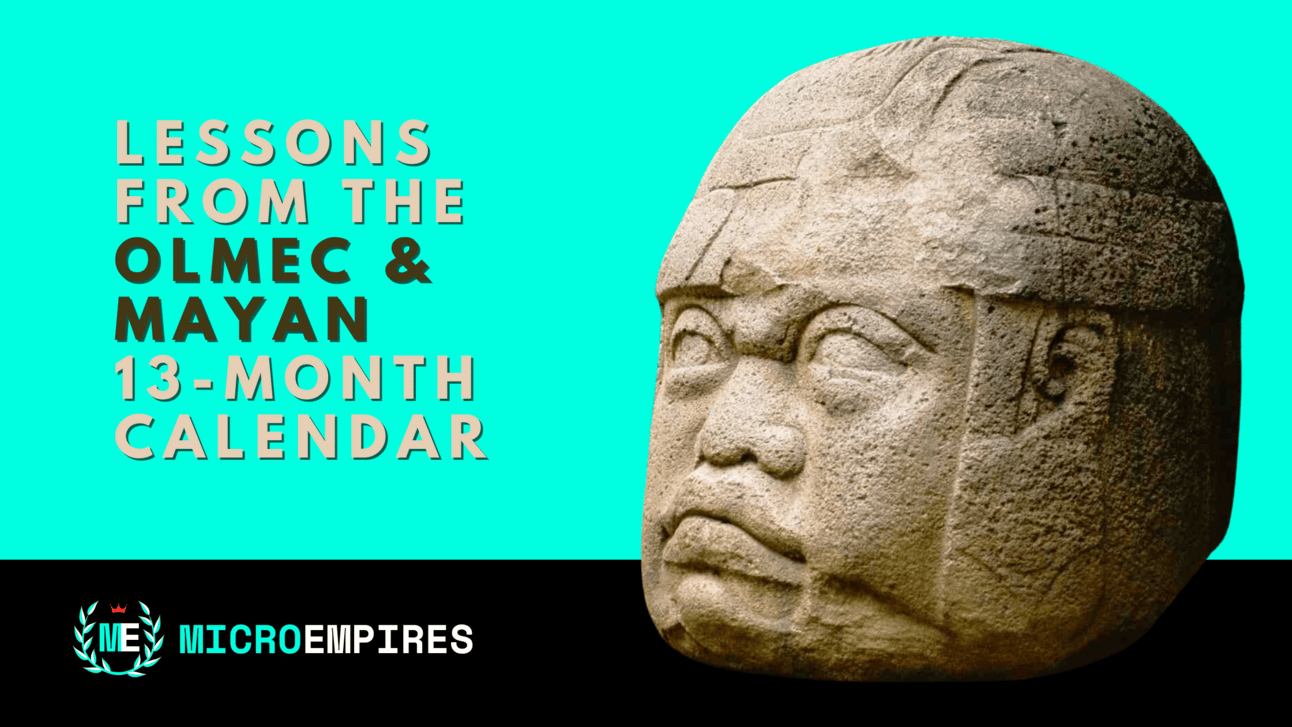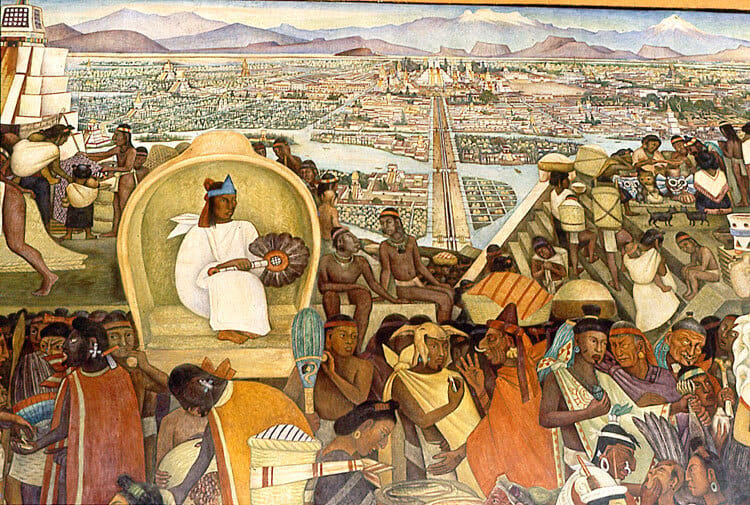Table of Contents

Introduction
Welcome to our latest edition, where we dive into ancient micro-empires like the Olmecs & Mayans, ancient Mesoamerican civilizations, and their influence on the 13-month calendar.
Now, this isn't just a history lesson. We're going to explore how this ancient calendar, with its unique approach to time, offers valuable insights for today's micropreneurs in terms of general time/energy management. And also how and why it’s making a return to modern conversations.
Whether you're running a small business or juggling multiple projects, understanding the the past can always lead to smarter, more efficient ways of working in the present.
Let’s dive in.
The Olmec Legacy & The Mayan Calendar
The Olmec civilization (c. 1200-400 BCE), significantly influenced later Mesoamerican cultures, including the Maya. This influence is particularly evident in the development of complex calendar systems. The Maya, who rose to prominence after the decline of the Olmecs, created intricate calendars that played a crucial role in their society. These calendars were not just tools for timekeeping but were deeply intertwined with their religious beliefs, agricultural practices, and trade activities.
The Maya developed a sophisticated 260-day calendar known as the Tzolkin, alongside a 365-day solar calendar, the Haab. These systems were likely influenced by earlier Olmec traditions. The Maya calendars were used to determine religious festival days and were crucial for agricultural planning, which in turn supported their extensive trade networks. The collapse of the Maya civilization, which remains a subject of debate among scholars, highlights the importance of adaptable economic and social systems, a lesson valuable for modern micropreneurs.1
Understanding The Mayan Calendar

Source: Jaguar Stones
Now, we’re going to do our best to explain the Mayan calendar, which is revered for its complexity and accuracy. To start, it consists of three main cycles: the Tzolk'in, Haab, and the Long Count. Each of these calendars serves a unique purpose and collectively reflects the Mayan understanding of time and cosmos.2
The Tzolk'in
The Tzolk'in, a 260-day sacred calendar, is central to Mayan culture and religious practices. Comprising 20 periods of 13 days each, it played a crucial role in determining the timing of religious and ceremonial events. This calendar is deeply intertwined with Mayan cosmology and is thought to be connected to astronomical phenomena like the movements of the Moon, the Sun, and even the human gestation period.
The Haab
In contrast, the Haab is a 365-day solar calendar consisting of 18 months of 20 days each, plus an additional short month of 5 days known as Wayeb. This calendar was fundamental for agricultural planning and marking the solar year. The Wayeb period, often considered a time of reflection and preparation for the new cycle, held significant cultural importance.
When combined, the Tzolk'in and Haab form a Calendar Round, a 52-year cycle that was not only significant to the Maya but also to other Mesoamerican cultures. This synchronization of calendars demonstrates the sophistication of the Mayan timekeeping system.
The Long Count

Source: How Did the Maya Count Time? The Collectors.
Additionally, the Long Count calendar was used for tracking longer historical periods, extending beyond the 52-year Calendar Round. This linear and cyclical method of timekeeping begins from a mythological starting-point, which corresponds to August 11, 3114 BCE in the Gregorian calendar. The Long Count calendar is notable for its role in Mayan mythology and its ability to date events far into the future or the past.
Overall, the Mayan calendar system, with its intricate cycles and astronomical basis, stands as a testament to the advanced understanding of time and the cosmos held by the ancient Maya civilization. Its accuracy and complexity have even influenced modern calendar systems, despite its primary purpose being to align Maya rulers' actions with historical and mythological events.
The Mayan Calendar & Commerce
The Mayan calendar's role in agriculture and commerce offers valuable insights for modern micropreneurs. In ancient Maya, agriculture, orchestrated by the calendar, laid the foundation for trade among city-states, similar to how today's entrepreneurs start with basic services or products and gradually expand their offerings. The growth of cities like Tikal and Calakmul, fueled by these trade systems, mirrors how successful small businesses can expand their market presence. The barter system, central to Mayan commerce, where goods like cacao seeds and obsidian were traded based on mutual needs, is reminiscent of modern barter exchanges or trade-by-barter platforms popular among micropreneurs for cost-saving and network-building.3

Source: Mexico Lore
Also, the extensive Mayan trade networks, reliant on natural pathways for transporting goods, can inspire contemporary entrepreneurs to leverage digital channels and e-commerce to expand their reach. The Mayans’ efficient movement of commodities across distances without modern transportation offers a parallel to today's digital marketplace, where physical boundaries are no longer a constraint. The exchange of both basic and luxury items in the Mayan economy highlights the importance of diversifying product offerings, catering to different market segments, and understanding consumer needs—key strategies for any successful micropreneur today.
The Shift from Natural to Modern Business Time Cycles
The shift from agrarian to industrial and service-based economies marked a significant transformation in economic history. The Industrial Revolution catalyzed this shift, transitioning economies that were primarily based on agriculture and handicrafts to those driven by large-scale industry, mechanized manufacturing, and factory systems. This revolution brought about new machines, power sources, and ways of organizing work, making industries more productive and efficient. It also led to the rise of new industries, such as the automobile industry in the late 19th century. This monumental change reshaped not only economies but also societies, setting the stage for the modern economic landscape that micropreneurs navigate today.
For micropreneurs, this historical context underscores the importance of adaptability and innovation in response to significant economic shifts. Something you should really always be on top of. Just as the transition to industrial and service-based economies opened new opportunities and required new strategies, today's micropreneurs (or any entrepreneur for that matter) must be agile in adapting to technological advancements and changing market dynamics. The history of the Olmec-influenced Maya serves as a reminder of the potential for growth and evolution in the face of economic transformation.
There’s also been various users on Twitter exploring the concept of a 13-month calendar in more recent times, and how people actually tried to return to it in the near past:
True Sustainability for the Modern Micropreneur
Modern micropreneurs can learn valuable lessons from the sustainability practices of the ancient Mayan civilization. The Mayans' approach, characterized by a "cosmology of conservation," was deeply integrated with their environment, ensuring they did not overuse resources.
This respect for nature, combined with a diverse approach to farming and resource use, allowed them to sustain their civilization for over 4,000 years without depleting their environment.
Such principles can be applied in today's entrepreneurial ventures, emphasizing sustainability, environmental responsibility, and diversity in business practices. These approaches can lead to more resilient and long-lasting business models, echoing the ancient Mayan wisdom in modern contexts — something that continues to increase in value.4
Avoiding Past Mistakes: Strategies for Micropreneurs
The collapse of the Mayan civilization, primarily attributed to environmental factors like prolonged drought and deforestation, holds critical lessons for modern micropreneurs. Jared Diamond, in his book "Collapse," suggests that the Mayans exacerbated their environmental challenges through deforestation, which was intensified by rapid development. This led to soil erosion and contributed to the inability to sustain the civilization. For today's entrepreneurs, this underscores the importance of environmental sustainability and responsible resource management.
Avoiding the over-exploitation of resources and understanding the long-term impacts of business activities on the environment are vital. Embracing sustainable practices and technologies not only contributes to environmental health but also ensures the longevity and resilience of their businesses in the face of ecological challenges. Something of short order these days, in an impatient world influenced by the speed of technological advances.
Conclusion
In conclusion, the Olmec-inspired Mayan civilization, with its intricate calendar system and sophisticated understanding of agriculture and urban planning, offers a wealth of knowledge for modern micropreneurs. The key takeaway is the importance of adaptability, sustainability, and community engagement in business practices.
Learning from the past, particularly the reasons behind the Mayan collapse, can guide entrepreneurs in making informed decisions that balance economic growth with environmental stewardship and social responsibility. These lessons from history remind us that success in business is not just measured by immediate gains but also by the ability to create a lasting, positive impact on the world.
What “impact” are you looking to create?
